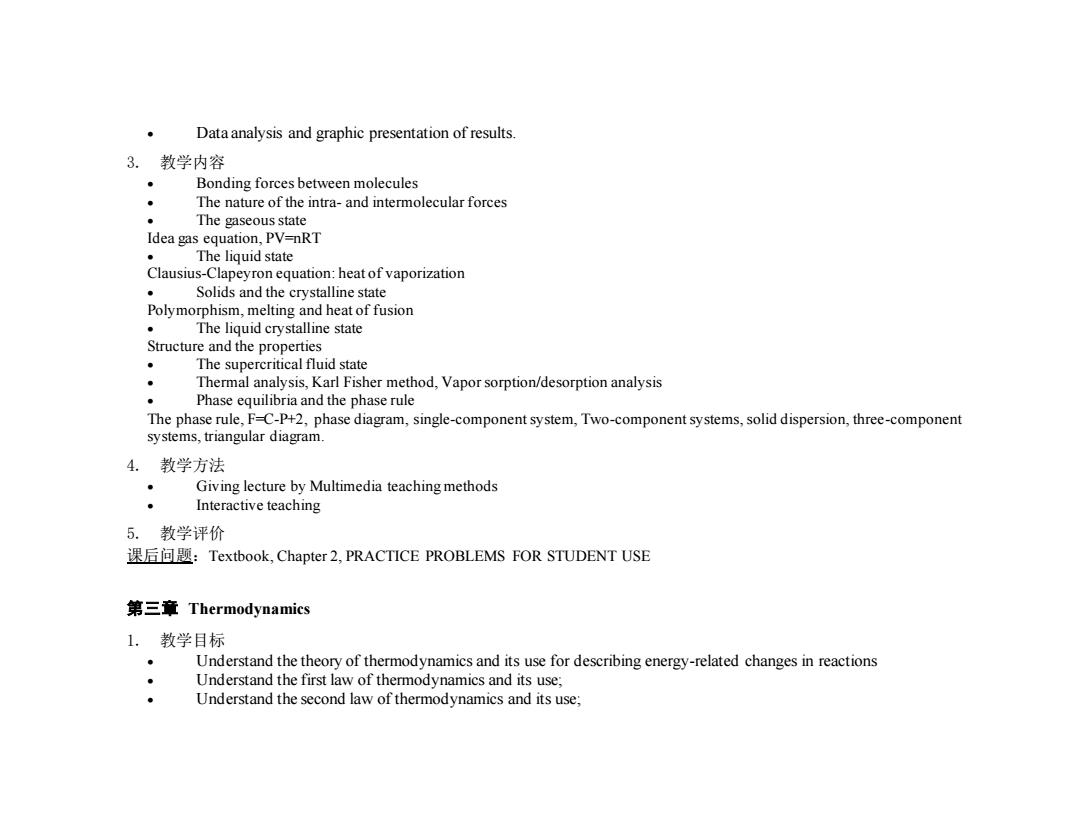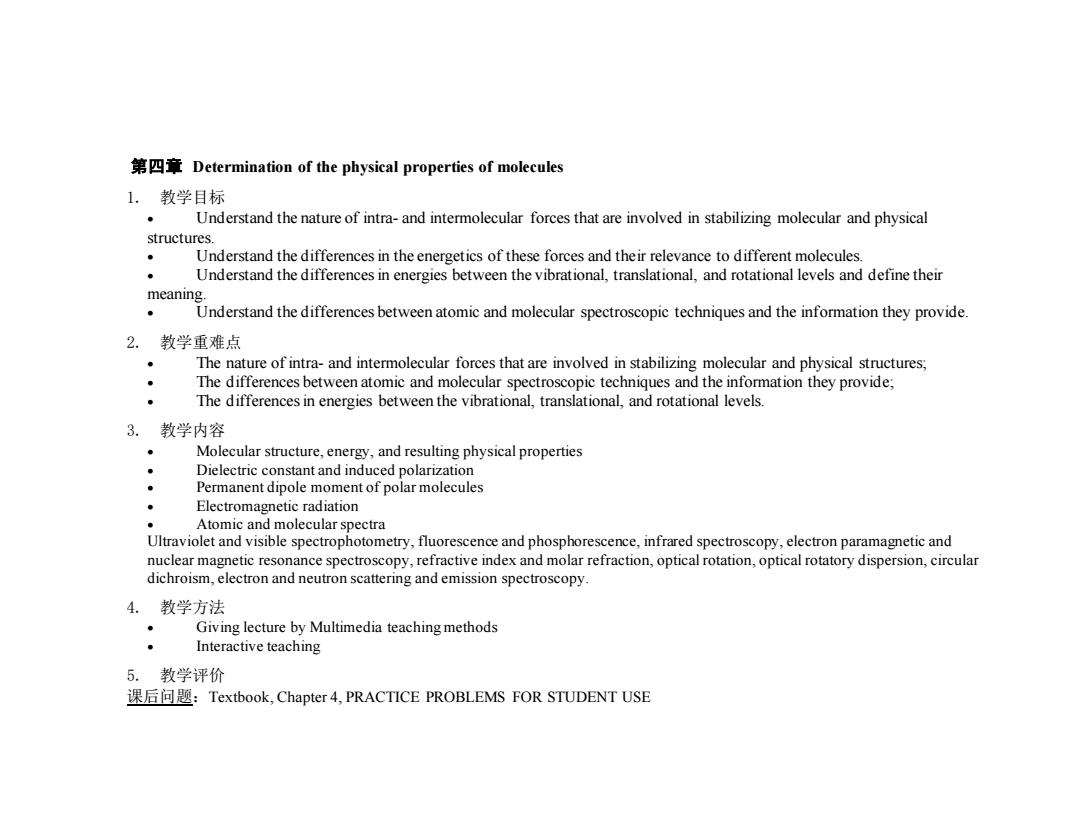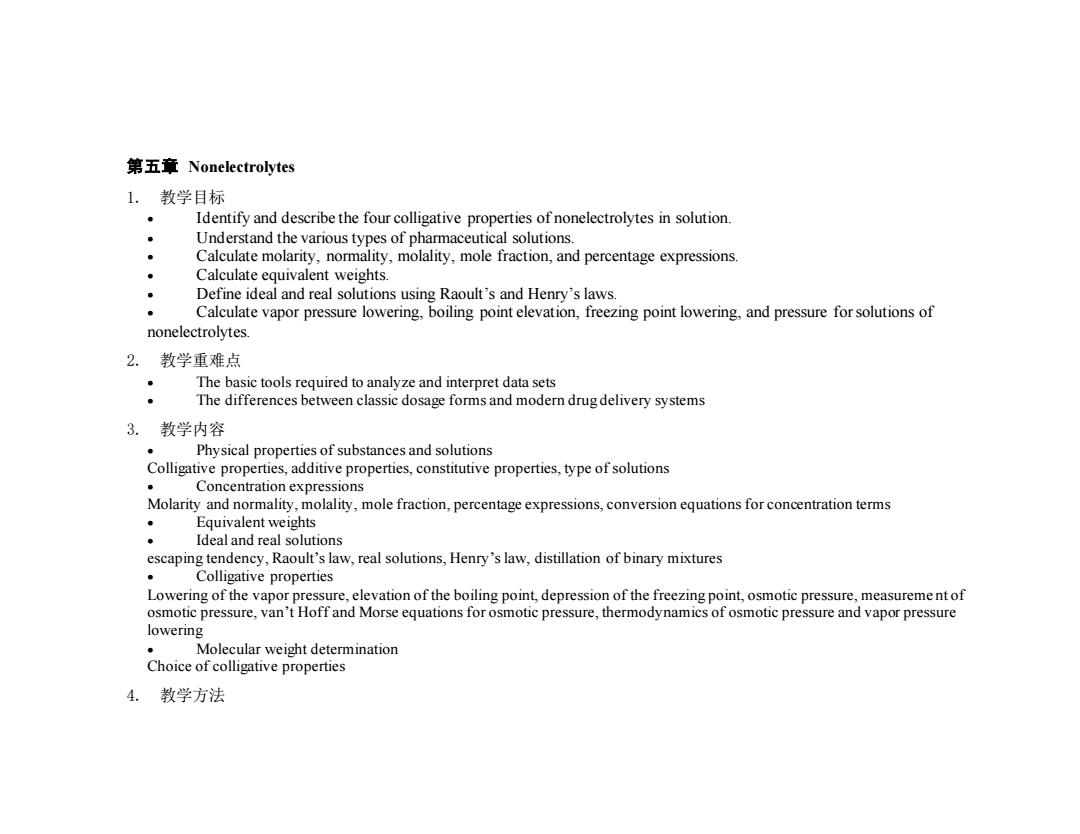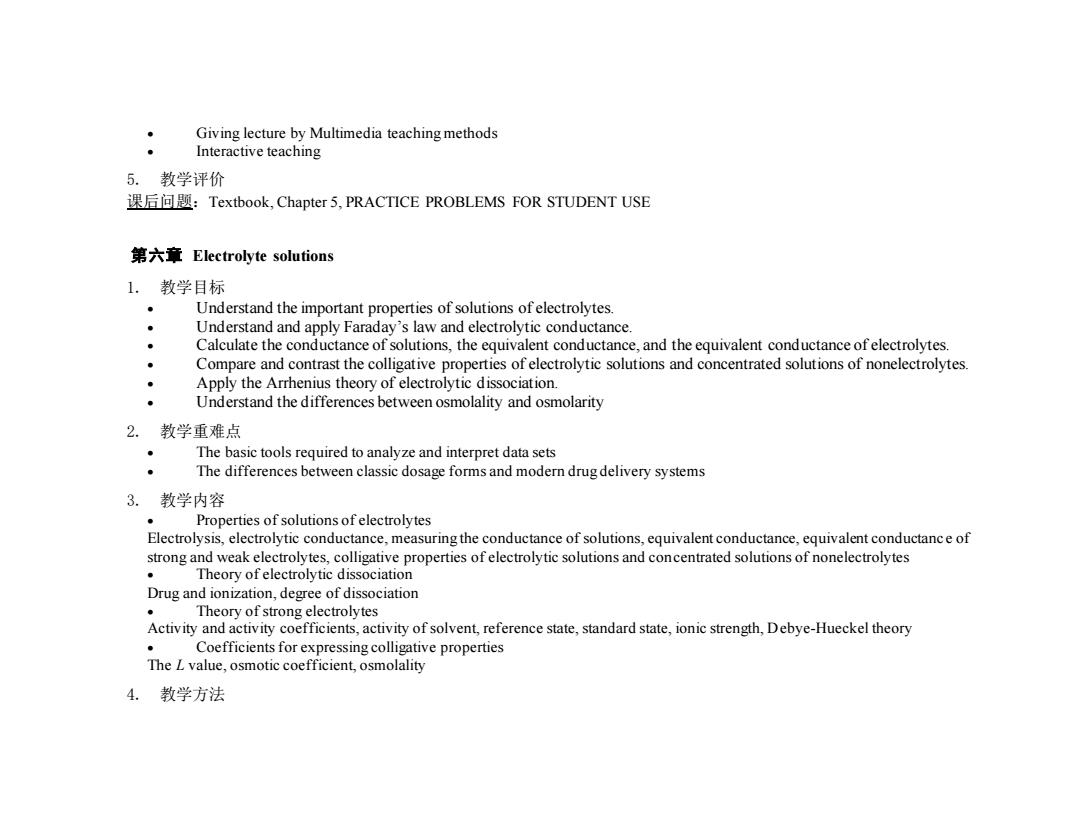
Data analysis and graphic presentation of results. 3. 教学内容 Bonding forces between molecules The nature of the intra-and intermolecular forces The gaseous state Idea gas equation,PV=nRT ·The liquid state Clausius-Clapeyron equation:heat of vaporization Solids and the crystalline state Polymorphism,melting and heat of fusion The liquid crystalline state Structure and the properties ● The supercritical fluid state Thermal analysis,Karl Fisher method,Vapor sorption/desorption analysis Phase equilibria and the phase rule The phase rule,F-C-P+2,phase diagram,single-component system,Two-component systems,solid dispersion,three-component systems,triangular diagram. 4.教学方法 Giving lecture by Multimedia teaching methods Interactive teaching 5.教学评价 课后问题:Textbook,Chapter2,PRACTICE PROBLEMS FOR STUDENT USE 第三章Thermodynamics 1.教学目标 Understand the theory of thermodynamics and its use for describing energy-related changes in reactions Understand the first law of thermodynamics and its use; Understand the second law of thermodynamics and its use;
• Data analysis and graphic presentation of results. 3. 教学内容 • Bonding forces between molecules • The nature of the intra- and intermolecular forces • The gaseous state Idea gas equation, PV=nRT • The liquid state Clausius-Clapeyron equation: heat of vaporization • Solids and the crystalline state Polymorphism, melting and heat of fusion • The liquid crystalline state Structure and the properties • The supercritical fluid state • Thermal analysis, Karl Fisher method, Vapor sorption/desorption analysis • Phase equilibria and the phase rule The phase rule, F=C-P+2, phase diagram, single-component system, Two-component systems, solid dispersion, three-component systems, triangular diagram. 4. 教学方法 • Giving lecture by Multimedia teaching methods • Interactive teaching 5. 教学评价 课后问题:Textbook, Chapter 2, PRACTICE PROBLEMS FOR STUDENT USE 第三章 Thermodynamics 1. 教学目标 • Understand the theory of thermodynamics and its use for describing energy-related changes in reactions • Understand the first law of thermodynamics and its use; • Understand the second law of thermodynamics and its use;

Understand the third law of thermodynamics and its use; Define and calculate free energy functions and apply them to pharmaceutically relevant issues; Understand the basic principles of the impact of thermodynamics on pharmaceutically relevant applications; Define the chemical potential and equilibrium processes. 2.教学重难点 The concepts of law of three laws of thermodynamic; Describe different processes using first-law equations; The heat changes accompanying isothermal chemical reactions at constant pressure or volume. The Efficiency of a Heat engine Entropy and calculation of the entropy change in isothermal process or at constant pressure Helmholtz Energy and Gibbs Energy 3.教学内容 The first law of thermodynamics Internal energy (E),AE=Q+W,isothermal and adiabatic processes,work of expansion against a constant pressure,maximum work,changes of state at constant pressure. Thermochemistry Heat of formation,heat of reaction from bond energies,heat of neutralization The second law of thermodynamics The efficiency of a heat engine,entropy,entropy and disorder The third law of thermodynamics Absolute entropies Free energy functions and applications Maximum net work,criteria of equilibrium and spontaneity,fugacity,open system,chemical potential,Clausius-Clapeyron equation,activity,standard free energy and the equilibrium constant 4.教学方法 Giving lecture by Multimedia teaching methods Interactive teaching 5.教学评价 课后问题:Textbook,Chapter3,PRACTICE PROBLEMS FOR STUDENT USE
• Understand the third law of thermodynamics and its use; • Define and calculate free energy functions and apply them to pharmaceutically relevant issues; • Understand the basic principles of the impact of thermodynamics on pharmaceutically relevant applications; • Define the chemical potential and equilibrium processes. 2. 教学重难点 • The concepts of law of three laws of thermodynamic; • Describe different processes using first-law equations; • The heat changes accompanying isothermal chemical reactions at constant pressure or volume. • The Efficiency of a Heat engine • Entropy and calculation of the entropy change in isothermal process or at constant pressure • Helmholtz Energy and Gibbs Energy 3. 教学内容 • The first law of thermodynamics Internal energy (E), ΔE = Q + W, isothermal and adiabatic processes, work of expansion against a constant pressure, maximum work, changes of state at constant pressure. • Thermochemistry Heat of formation, heat of reaction from bond energies, heat of neutralization • The second law of thermodynamics The efficiency of a heat engine, entropy, entropy and disorder • The third law of thermodynamics Absolute entropies • Free energy functions and applications Maximum net work, criteria of equilibrium and spontaneity, fugacity, open system, chemical potential, Clausius-Clapeyron equation, activity, standard free energy and the equilibrium constant 4. 教学方法 • Giving lecture by Multimedia teaching methods • Interactive teaching 5. 教学评价 课后问题:Textbook, Chapter 3, PRACTICE PROBLEMS FOR STUDENT USE

第四章Determination of the physical properties of molecules 1.教学目标 Understand the nature of intra-and intermolecular forces that are involved in stabilizing molecular and physical structures. Understand the differences in the energetics of these forces and their relevance to different molecules. Understand the differences in energies between the vibrational,translational,and rotational levels and define their meaning. Understand the differences between atomic and molecular spectroscopic techniques and the information they provide. 2.教学重难点 The nature of intra-and intermolecular forces that are involved in stabilizing molecular and physical structures; The differences between atomic and molecular spectroscopic techniques and the information they provide; The differences in energies between the vibrational,translational,and rotational levels. 3.教学内容 Molecular structure,energy,and resulting physical properties Dielectric constant and induced polarization Permanent dipole moment of polar molecules Electromagnetic radiation Atomic and molecular spectra Ultraviolet and visible spectrophotometry,fluorescence and phosphorescence,infrared spectroscopy,electron paramagnetic and nuclear magnetic resonance spectroscopy,refractive index and molar refraction,optical rotation,optical rotatory dispersion,circular dichroism,electron and neutron scattering and emission spectroscopy 4.教学方法 Giving lecture by Multimedia teaching methods Interactive teaching 5.教学评价 课后问题:Textbook,Chapter4,PRACTICE PROBLEMS FOR STUDENT USE
第四章 Determination of the physical properties of molecules 1. 教学目标 • Understand the nature of intra- and intermolecular forces that are involved in stabilizing molecular and physical structures. • Understand the differences in the energetics of these forces and their relevance to different molecules. • Understand the differences in energies between the vibrational, translational, and rotational levels and define their meaning. • Understand the differences between atomic and molecular spectroscopic techniques and the information they provide. 2. 教学重难点 • The nature of intra- and intermolecular forces that are involved in stabilizing molecular and physical structures; • The differences between atomic and molecular spectroscopic techniques and the information they provide; • The differences in energies between the vibrational, translational, and rotational levels. 3. 教学内容 • Molecular structure, energy, and resulting physical properties • Dielectric constant and induced polarization • Permanent dipole moment of polar molecules • Electromagnetic radiation • Atomic and molecular spectra Ultraviolet and visible spectrophotometry, fluorescence and phosphorescence, infrared spectroscopy, electron paramagnetic and nuclear magnetic resonance spectroscopy, refractive index and molar refraction, optical rotation, optical rotatory dispersion, circular dichroism, electron and neutron scattering and emission spectroscopy. 4. 教学方法 • Giving lecture by Multimedia teaching methods • Interactive teaching 5. 教学评价 课后问题:Textbook, Chapter 4, PRACTICE PROBLEMS FOR STUDENT USE

第五章Nonelectrolytes 1.教学目标 Identify and describe the four colligative properties of nonelectrolytes in solution. Understand the various types of pharmaceutical solutions. Calculate molarity,normality,molality,mole fraction,and percentage expressions. Calculate equivalent weights. Define ideal and real solutions using Raoult's and Henry's laws. Calculate vapor pressure lowering,boiling point elevation,freezing point lowering,and pressure for solutions of nonelectrolytes. 2.教学重难点 The basic tools required to analyze and interpret data sets The differences between classic dosage forms and modern drug delivery systems 3.教学内容 Physical properties of substances and solutions Colligative properties,additive properties,constitutive properties,type of solutions Concentration expressions Molarity and normality,molality,mole fraction,percentage expressions,conversion equations for concentration terms Equivalent weights Ideal and real solutions escaping tendency,Raoult's law,real solutions,Henry's law,distillation of binary mixtures Colligative properties Lowering of the vapor pressure,elevation of the boiling point,depression of the freezing point,osmotic pressure,measureme nt of osmotic pressure,van't Hoff and Morse equations for osmotic pressure,thermodynamics of osmotic pressure and vapor pressure lowering Molecular weight determination Choice of colligative properties 4.教学方法
第五章 Nonelectrolytes 1. 教学目标 • Identify and describe the four colligative properties of nonelectrolytes in solution. • Understand the various types of pharmaceutical solutions. • Calculate molarity, normality, molality, mole fraction, and percentage expressions. • Calculate equivalent weights. • Define ideal and real solutions using Raoult’s and Henry’s laws. • Calculate vapor pressure lowering, boiling point elevation, freezing point lowering, and pressure for solutions of nonelectrolytes. 2. 教学重难点 • The basic tools required to analyze and interpret data sets • The differences between classic dosage forms and modern drug delivery systems 3. 教学内容 • Physical properties of substances and solutions Colligative properties, additive properties, constitutive properties, type of solutions • Concentration expressions Molarity and normality, molality, mole fraction, percentage expressions, conversion equations for concentration terms • Equivalent weights • Ideal and real solutions escaping tendency, Raoult’s law, real solutions, Henry’s law, distillation of binary mixtures • Colligative properties Lowering of the vapor pressure, elevation of the boiling point, depression of the freezing point, osmotic pressure, measureme nt of osmotic pressure, van’t Hoff and Morse equations for osmotic pressure, thermodynamics of osmotic pressure and vapor pressure lowering • Molecular weight determination Choice of colligative properties 4. 教学方法

Giving lecture by Multimedia teaching methods Interactive teaching 5.教学评价 课后间题:Textbook,Chapter5,PRACTICE PROBLEMS FOR STUDENT USE 第六章Electrolyte solutions 1.教学目标 Understand the important properties of solutions of electrolytes. Understand and apply Faraday's law and electrolytic conductance. Calculate the conductance of solutions,the equivalent conductance,and the equivalent conductance of electrolytes. Compare and contrast the colligative properties of electrolytic solutions and concentrated solutions of nonelectrolytes. Apply the Arrhenius theory of electrolytic dissociation. Understand the differences between osmolality and osmolarity 2.教学重难点 The basic tools required to analyze and interpret data sets The differences between classic dosage forms and modern drug delivery systems 3.教学内容 Properties of solutions of electrolytes Electrolysis,electrolytic conductance,measuring the conductance of solutions,equivalent conductance,equivalent conductance of strong and weak electrolytes,colligative properties of electrolytic solutions and concentrated solutions of nonelectrolytes Theory of electrolytic dissociation Drug and ionization,degree of dissociation Theory of strong electrolytes Activity and activity coefficients,activity of solvent,reference state,standard state,ionic strength,Debye-Hueckel theory Coefficients for expressing colligative properties The L value,osmotic coefficient,osmolality 4.教学方法
• Giving lecture by Multimedia teaching methods • Interactive teaching 5. 教学评价 课后问题:Textbook, Chapter 5, PRACTICE PROBLEMS FOR STUDENT USE 第六章 Electrolyte solutions 1. 教学目标 • Understand the important properties of solutions of electrolytes. • Understand and apply Faraday’s law and electrolytic conductance. • Calculate the conductance of solutions, the equivalent conductance, and the equivalent conductance of electrolytes. • Compare and contrast the colligative properties of electrolytic solutions and concentrated solutions of nonelectrolytes. • Apply the Arrhenius theory of electrolytic dissociation. • Understand the differences between osmolality and osmolarity 2. 教学重难点 • The basic tools required to analyze and interpret data sets • The differences between classic dosage forms and modern drug delivery systems 3. 教学内容 • Properties of solutions of electrolytes Electrolysis, electrolytic conductance, measuring the conductance of solutions, equivalent conductance, equivalent conductanc e of strong and weak electrolytes, colligative properties of electrolytic solutions and concentrated solutions of nonelectrolytes • Theory of electrolytic dissociation Drug and ionization, degree of dissociation • Theory of strong electrolytes Activity and activity coefficients, activity of solvent, reference state, standard state, ionic strength, Debye-Hueckel theory • Coefficients for expressing colligative properties The L value, osmotic coefficient, osmolality 4. 教学方法